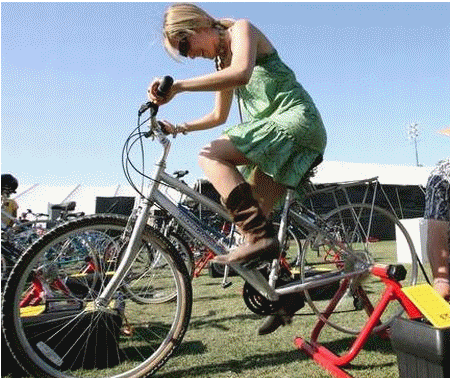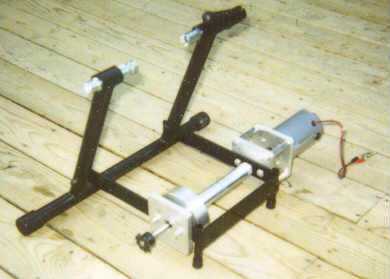Try our solar cost and savings calculator
Bicycle as energy generator
Collapse
X
-
One of the towns in my area (Woodsville NH) put in Low Pressure Sodium a decade or more ago as street lights. IMO, it make the town look like a warehouse yard or something. When you climb one of the local mountains, you can look around and see the glow of the different towns in the area and the ugly yellow glow allows you to pinpoint Woodsville. Something about all your lumens being on a single spectral line. -
Well you have discovered on of the dirty little secrets LED manufactures use to spin numbers. LED light is coherent, or as you have witnessed directional like a laser. So here are the two dirty secrets LED manufactures use to make claims.I have several LED bulbs -- Not sure how to best explain this on a forum -- LEDs are direction and therefore, if shined in the right direction, seemingly provide more light than identically rated incandescent or CFL because those bulbs spread light everywhere. It's the opposite case if shined in the wrong direction - that is, LEDs seem to provide less light than their incandescent and CFL counterparts when pointed in the wrong direction.
When they specify Lumens/watt it is at 1 meter in the focal spot of the LED. Move a few degrees in any direction and the light falls off a cliff. Whereas say for incandescent and florescent it an average rating at 1 meter in all directions. However that is not always a bad thing and is useful for task specific lighting like flashlights or reading lamps. But for area lighting it just suks.
Here is the biggest secret. When they perform the test they do so at full rated current, to a refrigerated unit, and only a brief milli-second pulse. Why would they do that? Simple as the led base driver heats up, light output decreases significantly as much as 75% or more. So by keeping it cold and only using pulses, no heat is generated. The other problem is if you operated LED's at their maximum current, they will only last about as long as a china made incandescent bulb.
Lastly what is known by most is LED CRI is not real good, at least not with some of the older designs. It is improving but still a lot of Blue Light Pollution
The technology is improving, and the problems will likely be overcome. But they are not quite ready for mainstream yet except in commercial applications, but homeowners are not likely to be able to afford commercial units.
For now the most efficient for home, industrial, and commercial is T5HO and T8 florescent lighting followed by CFL and LED. Difference between LED and CFL is really a tossup depending on the manufacture. Some better CFL's are quite a bit better then inexpensive LED, and some better LED's are better than inexpensive CFL. But for bang for the buck CFL still wins out unless cold temps are involved.
Now with all that said for outdoors everything changes. Outdoors low and high pressure sodium is king of efficiency, but the CRI is terrible, you know those yeller lights used on highways and street lamps. Police hate them because color cannot be identified.Leave a comment:
-
hmmmm. Sunking -- Interesting statement about L/w.
Can you point me to something better? Also, 12v DC is nice. The Edison base is nice, but not a necessity.
I have several LED bulbs -- Not sure how to best explain this on a forum -- LEDs are direction and therefore, if shined in the right direction, seemingly provide more light than identically rated incandescent or CFL because those bulbs spread light everywhere. It's the opposite case if shined in the wrong direction - that is, LEDs seem to provide less light than their incandescent and CFL counterparts when pointed in the wrong direction.
I interspersed my LED bulbs with CFLs. Physically place about every other one. This is my attempt at getting good light yet maintaining good energy efficiency. My LED bulbs are mostly 80 Lumen, 2.8 w bulbs. 80 Lumens is not quite enough light (but almost enough) when pointed in the right direction. The local utility company subsidized my purchase - that made the purchase much easier on my wallet.Leave a comment:
-
What seems stupid to me is that most exercise machines (like treadmills) actually use electrical energy, instead of generating it.
I always thought it would be a great gimmick to have all the exercise machines in a health club should be grid-tied and there should be a BIG meter on the wall of the club so everyone can see the combined wattage of all the machines. The the trainer could yell at everybody, "COME ON PEOPLE! PEDAL HARDER, WE'RE ALMOST AT 1 KILOWATT!"
Personally, I have never been to a health club. I get my exercise the old fashioned way. By hard work.Leave a comment:
-
Leave a comment:
-
Well, perhaps I've hijacked the thread and turned it into a lighting thread My apologies.
My apologies.
But that aside, my idea of bike power would be to supplement wind and sun. Some circuit or black box would serve as a "summation device" so this box would have wind + sun + bike = total power generated. On a still, cloudy day you'd have to conserve electricity and pedal a lot.
Back to the lights.
I like this 4 Watt guy with 200 Lumens. 12V DC with an Edison base:
Next choice is to modify this light fixture meant for bicycles. It has an advertised 900 Lumens, but in practice most people seem to claim it's closer to 600-700 Lumens range. I forget how many Watts:
BTW, I'm looking to light a 12x16 outdoor shed. I'd be in and out of it, so I wouldn't leave lights on all the time. Three of the 200 Lumen bulbs to do it, or maybe 2 of the bicycle light. Yikes, $150 in light bulbs for the latter. Thank God my plans are to win the lottery or else that would sound expensive.Leave a comment:
-
Leave a comment:
-
Well that would give you 100 watts x .5 hours x . 8 efficiency = 40 watt hours.
Enough to run 1 8 watt LED 5 hours, 2 for 2.5 hours, 3 for 1 hour and 40 minutes, and 1 heart attack
Leave a comment:
-
Power some LED light bulbs
So suppose a person could pump 100 Watts into a battery for 30 minutes. You could power two or three 8 Watt LED light bulbs for a few hours. Expensive light - yes. But so are other alternative energies. This would be approximately 300 USD for the lighting
Additionally, the wife and kids could each get a turn on the bike (ok, good luck with that).
I still like the idea. When I win the lottery, I'm building one. Will keep me from getting too fat from constantly eating out at gourmet restaurants.Leave a comment:
-
Hi Joey,
The best human efforts (Lance Armstrong type) at producing power over the course of an hour on a bicycle are around 300-400 Watts.
On your exercise bike you would achieve some small portion of that - maybe 10% if you ride hard.
RussLeave a comment:
-
bike generators
but this one is my favorite:
 physics,generator,bike,bicycle,alternator,pedal,power,current,fun,electricity,mechanics,science,math,project,engineering
physics,generator,bike,bicycle,alternator,pedal,power,current,fun,electricity,mechanics,science,math,project,engineering
Be sure to check out each of the 13 steps linked to from the top of that page. I priced a GM alternator from a junkyard at about $30 and the large capacitor at electronic surplus store at about $12. The big expense is the Ascent Magnetic 3 Level Trainer stand.Leave a comment:
-
Well you are a little older than I, but like you I learned the same info in grade school. Unfortunately schools do not teach math or science any more...
Leave a comment:
-
Generation of power...
Your heart is in the right place.It occurred to me that many stationary exercise bikes use the power generated by the person using it to power it's on board computer. Could the same principle be applied to supplement the power from solar panels? I'm thinking of getting a bike, modding it somehow yet to be determined (probably very similarly to a wind turbine) and hooking it up to a battery bank. Is there any reason why this wouldn't work? If it would work, it'll tap the biggest energy reserve in the world, our flabby guts!
Obviously you have access to the internet, and therefore all the info you need.
I learned in 9th grade science class,1954, all the answers to the question you pose.
If you missed out in science class, now that you have become interested, get on google and let the "games" begin.Leave a comment:
-
Are you sure you're not Ed Begley Jr riding the bike to make toast?Leave a comment:
-
Thanks for the humorous explanation. I was worried that something like this wouldn't be possible. Where can I learn more about energy generation? How can you estimate the amount of power that would come from a system like this? If that amount was at least a little something, I might go ahead and do it for the added benefit of exercise. While the energy generation might not be high, coupled with the exercise that it would provide (of which I'm doing absolutely none right now) it might be worth it for me.
I was worried that something like this wouldn't be possible. Where can I learn more about energy generation? How can you estimate the amount of power that would come from a system like this? If that amount was at least a little something, I might go ahead and do it for the added benefit of exercise. While the energy generation might not be high, coupled with the exercise that it would provide (of which I'm doing absolutely none right now) it might be worth it for me.
Leave a comment:
Copyright © 2014 SolarReviews All rights reserved.
Powered by vBulletin® Version 6.1.0
Copyright © 2025 MH Sub I, LLC dba vBulletin. All rights reserved.
Copyright © 2025 MH Sub I, LLC dba vBulletin. All rights reserved.
All times are GMT-5. This page was generated at 08:21 PM.




Leave a comment: